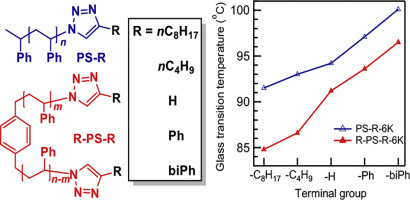Reactive & Functional Polymers ( IF 4.5 ) Pub Date : 2020-03-13 , DOI: 10.1016/j.reactfunctpolym.2020.104566 Yuchun Huang , Yujian Liu , Saleem Muhammad , Qun Jia , Yuansheng Ding , Yougen Chen

|
The present work describes the detailed macromolecular design, synthesis, and characterization of a series of mono- and bi-terminal functionalized polystyrenes (PSs) by the combination of atom transfer radical polymerization (ATRP) and copper(I)-catalyzed alkyne-azide cycloaddition (CuAAC) reaction. We further study the effect of the incorporated end groups on the glass transition behavior of the resulting polymers. The mono and bi functionalized polystyrenes were synthesized by using 1-phenylethyl bromide and 1,4-bis(bromomethyl)benzene as the initiators to form bromo mono-end functionalized PS (PS-Br) and bromo bi-terminal functionalized PS (Br-PS-Br), respectively. PS-Br and Br-PS-Br were then transformed to azido mono- and bi-terminal functionalized PSs (PS-N3 and N3-PS-N3) by SN2-type reaction with sodium azide. PS-N3 and N3-PS-N3 were then subjected to CuAAC reactions with various alkynes like 1-decyne, 1-hexyne, trimethylsilylacetylene, phenylacetylene, and 4-ethynyl-1,1′-biphenyl respectively to give a series of alkyl or aromatic mono- and bi-terminal functionalized PSs (PS-Rs and R-PS-Rs), such as PS-Rs of PS-C8H17, PS-C4H9, PS-SiMe3, PS-Ph, PS-biPh, and R-PS-Rs of C8H17-PS-C8H17, C4H9-PS-C4H9, SiMe3-PS-SiMe3, Ph-PS-Ph, and biPh-PS-biPh. PS-SiMe3 and SiMe3-PS-SiMe3 were then transformed to the corresponding PS-H and H-PS-H through the detrimetylsilylation reaction with tetra-n-butylammonium fluoride (TBAF). Among the five end groups, -C8H17 and -C4H9 were with great flexibility; -H was viewed as a standard; and -Ph and -biPh groups represented the typical rigid moieties. The effect of these end groups on glass transition behavior was thoroughly investigated based on the above macromolecular design.
中文翻译:

通过ATRP和点击化学轻松实现聚苯乙烯的末端官能化:链末端对玻璃化转变温度的影响
本工作介绍了通过原子转移自由基聚合(ATRP)和铜(I)催化的炔-叠氮化物环加成反应的组合,对一系列单端和双端官能化聚苯乙烯(PSs)进行详细的大分子设计,合成和表征(CuAAC)反应。我们进一步研究了引入的端基对所得聚合物的玻璃化转变行为的影响。以1-苯乙基溴化物和1,4-双(溴甲基)苯为引发剂合成单和双官能化聚苯乙烯,以形成溴单端官能化PS(PS-Br)和溴双端官能化PS(Br- PS-Br)。然后将PS-Br和Br-PS-Br转化为叠氮基单端和双端功能化PS(PS-N 3和N 3 -PS-N3)用S Ñ与叠氮化钠2型反应。然后使PS-N 3和N 3 -PS-N 3与各种炔烃(例如1-癸炔,1-己炔,三甲基甲硅烷基乙炔,苯基乙炔和4-乙炔基-1,1'-联苯)进行CuAAC反应,得到一系列烷基或芳族单端和双端官能化PS(PS-R和R-PS-R)的数量,例如PS-C 8 H 17,PS-C 4 H 9,PS-SiMe 3,PS的PS-R C 8 H 17 -PS-C 8 H 17,C 4 H 9 -PS-C的-Ph,PS-biPh和R-PS-Rs4 H 9,SiMe 3 -PS-SiMe 3,Ph-PS-Ph和biPh-PS-biPh。然后通过与四正丁基氟化铵(TBAF)的脱三甲基甲硅烷基化反应,将PS-SiMe 3和SiMe 3 -PS-SiMe 3转化为相应的PS-H和H-PS-H 。在五个端基中,-C 8 H 17和-C 4 H 9具有很大的灵活性。-H被视为标准;-Ph和-biPh基团代表典型的刚性部分。基于上述大分子设计,彻底研究了这些端基对玻璃化转变行为的影响。











































 京公网安备 11010802027423号
京公网安备 11010802027423号